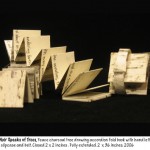Henry David Thoreau only spent two years in solitude at Walden Pond. The remainder of his short life reflected some of the lessons he learned during that time as he struggled to find a balance between civilization and the wilderness. I struggle to find this balance within myself daily, asking the questions: What is wilderness, what is wildness? Here is how Thoreau addresses both of these questions in the essay Walking:
Walking
…and what I have been preparing to say is, that in Wildness is the preservation of the World. Every tree sends its fibers forth in search of the Wild. The cities import it at any price. Men plow and sail for it. From the forest and wilderness come the tonics and barks which brace mankind.
Life consists with Wildness. The most alive is the wildest. Not yet subdued to man, its presence refreshes him. One who pressed forward incessantly and never rested from his labors, who grew fast and made infinite demands on life, would always find himself in a new country or wilderness, and surrounded by the raw material of life. He would be climbing over the prostrate stems of primitive forest trees.
Can making an image that captures the essence of wildness bring its force and power to inside spaces? Or to treeless spaces? These questions surfaced during my own walks in the wilderness and the wildness of my mind. The tree rubbings attempt to answer them.
I collaborate with the tree when making a rubbing by entering its intimate space. We exchange something beyond the transfer of texture to paper. The tree rubbings reflect moments from these walks, whether in the forest, the city park or suburban landscape. They mark time spent in the wilderness. They cultivate wildness in my soul. They record a fleeting experience; a dance of a grove, or of solitude; the movement of life; the solidity of existence—whether in the wilderness or a city square.
They evolved out of a larger tree collaboration project that extended around the world. Friends and family members tied paper on trees and left it there for one calendar year, barring accidental or intentional removal. The trees marked the paper with its sap and in concert with the elements of weather. The tree stood for me, and the paper represented how time marks me through the trials of life’s elements.
Now, the rubbings that I do, document time spent linking myself with the natural world. I begin with charcoal or graphite, transferring the texture to paper. The rubbing returns with me to my studio where I work back into the patterns and marks, or I transform it into a book, a map or other creation. These creations are supplemented with text derived from reflective, historical and observational writings.
More recently, the rubbings are coming into my work as collage elements, look for them here.















